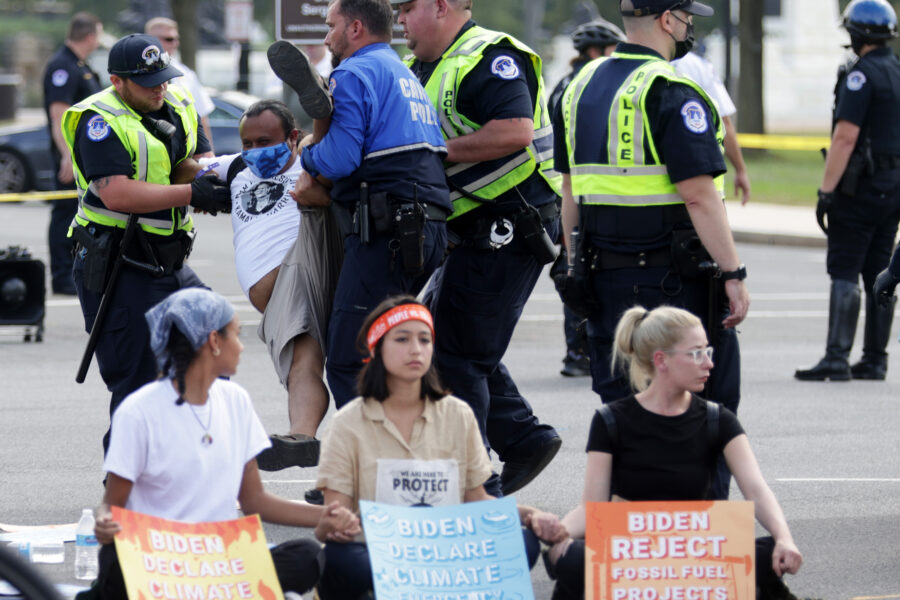As Baltimore’s Sewer System Buckles Under Extreme Weather, City Refuses to Help Residents With Cleanup Efforts
A sewage cleanup program meant to assist Baltimore residents with backups in their homes has been in limbo for more than a year because of a deadlock between city authorities, the U.S. Environmental Protection Agency (EPA) and the Maryland Department of the Environment (MDE).
The haggling over the future scope of the cleanup program has left Baltimoreans in the lurch and angered advocates who accuse city officials of exaggerating the cleanup costs and misleading elected officials.
Baltimore City runs two cleanup programs aimed at providing relief to homeowners, tenants and property managers dealing with sewage backup entering their homes due to wet weather conditions and clogged public pipes.
The programs resulted from a 2017 modified consent decree between Baltimore City, the EPA and MDE, which required the city to set aside $2 million a year to help residents with the costs of sewage cleanup. The Expedited Reimbursement Program covers the cost of property cleanup caused by heavy rain and pipe capacity issues, and the Sewage Onsite Support (SOS) program, launched in 2021, directly pays third-party vendors to clean and disinfect homes when overflowing sewer pipes cause sewage to flow backward and enter homes through toilets and sinks.
Explore the latest news about what’s at stake for the climate during this election season.
Sewage backups are a recurring and expensive problem for a large number of Baltimore residents. A 2021 report by the Department of Public Works estimated at least 8,860 sewage backups in the city between 2018 and 2021 caused by problems in the city-owned sewage pipes.
The current deadlock ensued when, in 2022, the city submitted a plan to the EPA and the MDE proposing to continue only the SOS program on a long-term basis with benefits limited to backups caused by storm-related flooding. Advocates want the city to include both dry and wet weather events in its scope, including backups caused by blockages and cracks in pipes, a common and pervasive problem because of decades of neglect and under-investment in the city’s sewage system.
In May 2023, the EPA approved the city’s proposal to continue with the SOS program but required that the $2 million in cleanup assistance must include all backups, including those resulting from clogged and cracked sewage lines. “The SOS program must address all backups that originate in the sewer mainline,” the agency said in its letter.
Quoting 2021 data, the EPA letter estimated an average of 4,400 annual backups reported between 2017 and 2021. Because of the limited scope of the city’s cleanup program, the letter said, less than 20 percent of backups qualified for the SOS program, which spent only $21,019 in assistance from 2018 to 2022.
In view of the city’s miniscule spending, the EPA concluded that Baltimore could easily cover additional claims by including in its scope those backups that occur in all types of weather and from blockages in the city-owned pipes.
But DPW refused to heed the EPA’s order and has since maintained that expanding cleanup benefits went beyond requirements of the modified consent decree, leaving the agencies locked in a dispute resolution process with no end in sight.
“The city and the agencies are engaged in negotiations to address the ongoing dispute concerning the SOS program,” said Amanda Miles, public affairs specialist with the EPA Mid-Atlantic region office.
In an emailed response, Miles said the EPA’s guiding principle in the negotiations is the protection of human health and the environment under the Clean Water Act and the modified consent decree. “The case team is seeking a fair and equitable solution that furthers the protection of human health, and they are mindful of the concerns raised by the community.”
The city officials were just as reserved in their comments shared with Inside Climate News.
“The DPW’s senior leadership have held ongoing meetings with the EPA and the MDE on potential changes to the Sewage Onsite Support (SOS) Cleanup Program,” said Mary Stewart, DPW’s public relations officer.
“From the beginning, DPW’s goal has been to work with both agencies to develop a program that ensures any expansion of the SOS cleanup program will treat all residents fairly and ensure that any citizen who experiences a qualifying backup will be eligible for assistance under the program,” Stewart added.
Jay Apperson, deputy director with the MDE’s office of communications, said in a statement: “The negotiations involving Baltimore City’s program to address sewage backups are ongoing. We know this is an important public health issue affecting city residents and we are working toward resolving this matter as soon as possible.”
During a June City Council hearing on the 2025 budget, a number of council members asked DPW officials to explain how much money had been disbursed from the two cleanup programs in the last 2 years and why so few applications were approved.
Richard Luna, DPW’s deputy director, told the council members that in 2023, 27 applicants applied for funds under the Expedited Reimbursement Program and none qualified; in 2024, 3 applicants received around $14,900 from 33 applications. Under the SOS program, Luna said, around $77,000 was given to 11 households in 2023 and four households properties received nearly $44,000 in 2024.
“There’s strict criteria for anybody experiencing a backup to be able to apply and be eligible to receive that type of funding. So that’s why you see the lower number that qualify,” Luna said. He added that DPW was in active negotiations with the MDE and EPA about modifications to the SOS program.
Kristerfer Burnett, the council member representing Southwest Baltimore, pressed DPW officials to explain why the agency was pushing against the EPA and MDE’s order to include both wet and dry weather events in the scope of its cleanup assistance.
“The $2 million will be exhausted in the first few months and the rest of the year you’re not going to have anybody who’s getting anything,” said DPW Director Khalil Zaied, adding that the agency estimated it would require $14 million to accommodate backups from dry and wet weather events.
The committee asked Zaied if the $14 million was a realistic estimate and how the department would spend that amount when they could only disburse a fraction of the $2 million budgeted since 2017. Zaied did not have a definitive answer.
Advocates said it was appalling to see DPW misleading elected officials by misquoting facts.
“DPW’s 2021 report estimated $14 million to cover all sewer backups in the city, anything that gets reported to DPW, even if the plumbing inside of your own house causes a backup to happen. That’s not what we’ve advocated that the city should cover, and that’s not what the EPA order says that the city should cover,” said Jennifer Kunze, Maryland organizing director of the nonprofit Clean Water Action.
She said it was “appalling and disturbing” to see DPW fight against the EPA order to expand the scope of the city’s cleanup program and to see the process drag out for so long.
“And while these deliberations are stretching out, people are continuing to have sewer backups,” she said. “We’ve heard from people who have had sewer backups just within the past couple of months and have been forced to clean them up unsafely because the city is refusing to provide that help, even when it’s city infrastructure that caused it in the first place.”
A 2019 study documented a number of diseases linked to fecal matter in Baltimore wastewater, which often inundated residents’ homes and basements as a result of a sewage backup. Raw sewage can be especially harmful when residents are forced to undertake the cleanup themselves because it contains pathogens such as bacteria, viruses, and parasites, the study said.
“It’s a matter of environmental justice and climate resiliency that that is happening and the city’s infrastructure isn’t able to handle it.”
The study warned that several groups are likely to be more susceptible to illnesses resulting from exposure to raw sewage, including children and people who are pregnant, because they tend to have weakened or underdeveloped immune systems. “Those who are immunocompromised are also more at risk than the average adult,” the study said.
Climate change is worsening the situation, Kunze cautioned, with more frequent and severe rains causing more sewage overflows and backups into people’s homes.
“It’s a matter of environmental justice and climate resiliency that that is happening and the city’s infrastructure isn’t able to handle it,” she said. “The city should be cleaning up these sewage floods when they happen in people’s homes and take climate change and climate resiliency seriously.”
The study, “Residential Sewage Backups in Baltimore City,” also states climate change is causing increased precipitation and flooding, which city officials have to factor in when planning the future investments in the sewer system.
“If the city is not accounting for these future changes,” said Faith C. Ezell, the study’s author, “overflows and breaks in pipes due to pressure in the system may be an upcoming reality.”
About This Story
Perhaps you noticed: This story, like all the news we publish, is free to read. That’s because Inside Climate News is a 501c3 nonprofit organization. We do not charge a subscription fee, lock our news behind a paywall, or clutter our website with ads. We make our news on climate and the environment freely available to you and anyone who wants it.
That’s not all. We also share our news for free with scores of other media organizations around the country. Many of them can’t afford to do environmental journalism of their own. We’ve built bureaus from coast to coast to report local stories, collaborate with local newsrooms and co-publish articles so that this vital work is shared as widely as possible.
Two of us launched ICN in 2007. Six years later we earned a Pulitzer Prize for National Reporting, and now we run the oldest and largest dedicated climate newsroom in the nation. We tell the story in all its complexity. We hold polluters accountable. We expose environmental injustice. We debunk misinformation. We scrutinize solutions and inspire action.
Donations from readers like you fund every aspect of what we do. If you don’t already, will you support our ongoing work, our reporting on the biggest crisis facing our planet, and help us reach even more readers in more places?
Please take a moment to make a tax-deductible donation. Every one of them makes a difference.
Thank you,
David Sassoon
Founder and Publisher
Vernon Loeb
Executive Editor
Share this article
Disclaimer: The copyright of this article belongs to the original author. Reposting this article is solely for the purpose of information dissemination and does not constitute any investment advice. If there is any infringement, please contact us immediately. We will make corrections or deletions as necessary. Thank you.








